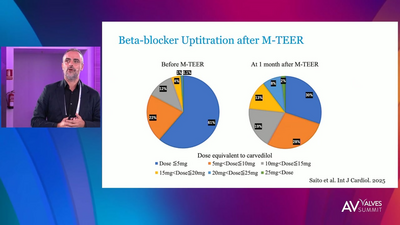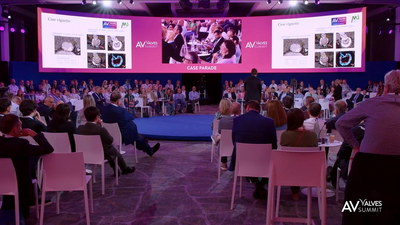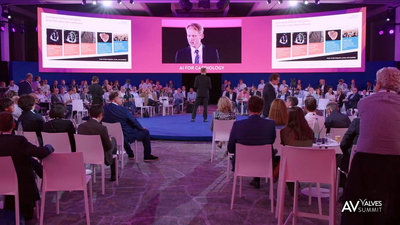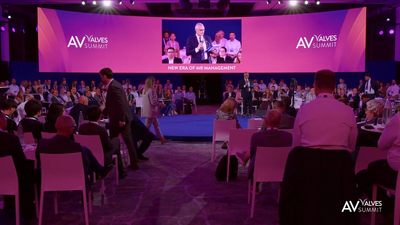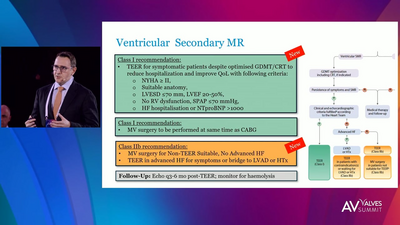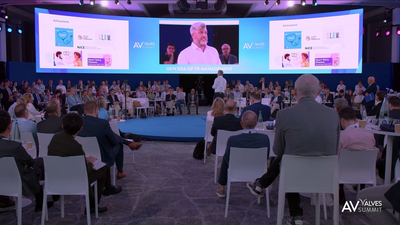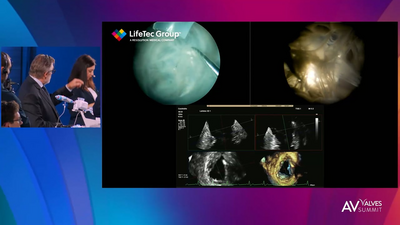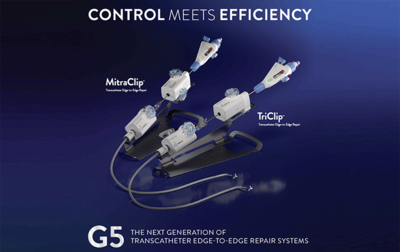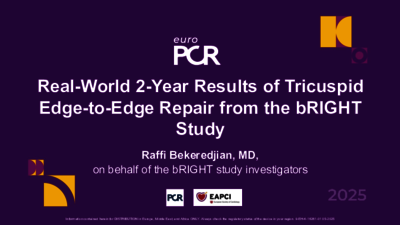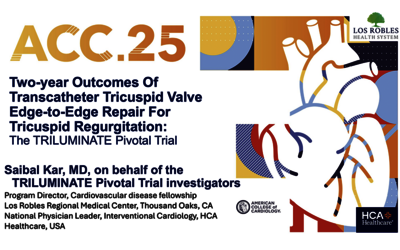Tricuspid Regurgitation (TR) is a complex disease that has multiple causes, and is associated with high rates of morbidity and mortality.1,2 TR is highly prevalent, and among valve diseases, is one of the most undertreated.1,3 If left untreated, TR initiates a cascade of events that can lead to right-sided Heart Failure (HF) and death.4
Most early-stage TR is clinically silent,1 and even with severe TR, some patients may be asymptomatic.27 In patients who become symptomatic of TR, the prevalence and severity of the symptoms are greater in patients with more severe TR.7,8,28–30
The symptoms of TR (when present) include:18,20







In patients with severe TR or advanced right-side HF and therefore poor cardiac function, these symptoms may include decreased cardiac output, right atrial hypertension, fluid retention (peripheral or pulmonary), dyspepsia, ascites, or indigestion.13,31
TR can cause or aggravate the signs and symptoms of HF,32 and symptomatic patients with TR commonly present with the symptoms of HF, and not the TR itself.13,20,33
Key cardiac and non-cardiac comorbidities associated with TR
CARDIAC COMORBIDITIES
- Reduced Left Ventricular Ejection Fraction (LVEF), moderate/severe Mitral Regurgitation (MR), and AF are common comorbidities in patients with TR.7,8,28–30
- Severe secondary TR may cause HF and is associated with heart transplant and Valvular Heart Disease (VHD).8,34
- Severe secondary TR is significantly (p<0.001) associated with pulmonary hypertension.34
NON-CARDIAC COMORBIDITIES
- Patients with TR commonly suffer from diabetes mellitus, chronic kidney disease, or dyslipidaemia.35,36
- Severe TR can also lead to liver and renal impairment.37
LEARN MORE:
VHD may be detected incidentally during patient examinations, such as the presence of heart murmur during a physical examination, or heart valve abnormalities on chest imaging or non-invasive testing (i.e. echocardiography)28,33,36,38
Methods for diagnosis and assessment of TR
CHEST X-RAY
- Determine the presence or absence of pulmonary congestions/other lung pathologies which may be present in patients with VHD.19
- Chest X-ray is also used to identify cardiomegaly of the right-side heart, however there are no specific findings that would indicate TVD.13
ELECTROCARDIOGRAPHY (ECG)
- ECG is used to investigate the heart rhythm and identify if AF is present.19
- Elevated right atrial pressure with “c-V” wave is indicative of severe TR.19
ECHOCARDIOGRAPHY
- Echocardiography is the key technique used to confirm the diagnosis of VHD, as well as to assess its aetiology, mechanisms, function, severity, and prognosis.39
- Echocardiography is typically used in assessing both the mechanism and severity of TR.31
- TransThoracic Echocardiography (TTE) can distinguish between primary and secondary TR, identify comorbid LSHD, and estimate pulmonary artery systolic pressure.19
- In the presence of TR, tricuspid valve analysis is mandatory; two-dimensional (2D)-TTE imaging is the technique of choice. Three-dimensional (3D)-TTE can be used as an additive approach.33
- TransoEsophageal Echocardiography (TEE) is advised in case of suboptimal TTE images. Distinction between primary and secondary TR is warranted.33
- TEE can also be used during transcatheter procedures, to guide the device into the correct position.40
COLOUR FLOW DOPPLER
- Colour flow imaging can identify small regurgitant jets (jets of backward flowing blood), and can be used to diagnose TR, however it is not recommended to assess TR severity.33
COMPUTED TOMOGRAPHY (CT) IMAGING
CT can provide a detailed image of the valve anatomy, especially of the systolic and diastolic ventricle geometry. This information is key for pre-procedural planning of a catheter-based intervention.41,42
CARDIOVASCULAR MAGNETIC RESONANCE (CMR) IMAGING
CMR imaging is typically used as a test for evaluating RV function.43
Although CMR assessment of TR is feasible, it is less established than for other valves.44
Patients with inadequate echocardiography may receive CMR imaging to assess the severity of valvular lesions, ventricular volume, or systolic function, thus CMR can aid the evaluation of TR severity.39

An interactive tool for in-hospital mortality prediction. It is a simple, accurate and dedicated risk-score model to predict outcome after isolated tricuspid valve surgery for severe tricuspid regurgitation at an individual level according to the pre-operative clinical, biological and echocardiographic presentation.
DOWNLOAD THE APP

An interactive tool for in-hospital mortality prediction. It is a simple, accurate and dedicated risk-score model to predict outcome after isolated tricuspid valve surgery for severe tricuspid regurgitation at an individual level according to the pre-operative clinical, biological and echocardiographic presentation.
Hub
TV
HUB
- Topilsky Y, Maltais S, Medina Inojosa J et al. Burden of tricuspid regurgitation in patients diagnosed in the community setting. JACC Cardiovasc Imaging. 2019;12(3):433–442. doi.org/10.1016/j.jcmg.2018.06.014.
- Taramasso M, Gavazzoni M, Maisano F. Is tricuspid regurgitation a prognostic interventional target or is it just an indicator of worst prognosis in heart failure patients? Eur Heart J. 2019;40(5):485–487. doi.org/10.1093/eurheartj/ehy722.
- Enriquez-Sarano M, Messika-Zeitoun D, Topilsky Y et al. Tricuspid regurgitation is a public health crisis. Prog Cardiovasc Dis. 2019;62(6):447–451. doi.org/10.1016/j.pcad.2019.10.009.
- Goliasch G, Mascherbauer J. Interventional treatment of tricuspid regurgitation. Wien Klin Wochenschr. 2020;132:57–60. doi.org/10.1007/s00508-020-01621-0.
- Vemulapalli S, Kerr MSD, Roberts GJ et al. Tricuspid valve disease prevalence and the impact of tricuspid valve surgery on cardiovascular events and hospital resource use in medicare beneficiaries. Am Heart J. 2022;245:100–109. doi.org/10.1016/j.ahj.2021.12.001.
- Amat-Santos IJ, Castrodeza J, Nombela-Franco L et al. Tricuspid but not mitral regurgitation determines mortality after TAVI in patients with non-severe mitral regurgitation. Rev Esp Cardiol (Engl Ed). 2018;71(5):357–364. doi.org/10.1016/j.rec.2017.08.019.
- Kammerlander AA, Marzluf BA, Graf A et al. Right ventricular dysfunction, but not tricuspid regurgitation, is associated with outcome late after left heart valve procedure. J Am Coll Cardiol. 2014;64(24):2633–2642. doi.org/10.1016/j.jacc.2014.09.062.
- Grupper A, Killu AM, Friedman PA et al. Effects of tricuspid valve regurgitation on outcome in patients with cardiac resynchronization therapy. Am J Cardiol. 2015;115(6):783–789. doi.org/10.1016/j.amjcard.2014.12.046.
- Kalbacher D, Schafer U, von Bardeleben RS et al. Impact of tricuspid valve regurgitation in surgical high-risk patients undergoing MitraClip implantation: results from the TRAMI registry. EuroIntervention. 2017;12(15):e1809–e1816. eurointervention.pcronline.com/article/impact-of-tricuspid-valve-regurgitation-in-surgical-high-risk-patients-undergoing-mitraclip-implantation-results-from-the-trami-registry.
- Nath J, Foster E, Heidenreich PA. Impact of tricuspid regurgitation on long-term survival. J Am Coll Cardiol. 2004;43(3):405–409. doi.org/10.1016/j.jacc.2003.09.036.
- Prihadi EA, van der Bijl P, Gursoy E et al. Development of significant tricuspid regurgitation over time and prognostic implications: new insights into natural history. Eur Heart J.2018;39(39):3574–3581. doi.org/10.1093/eurheartj/ehy352.
- Testa L, Latib A, De Marco F et al., editors. Euro15A-POS290: Interaction between tricuspid regurgitation and transcatheter aortic valve replacement. Insight from the Italian registry. EuroPCR; 2015; Paris, France.
- Shah PM, Raney AA. Tricuspid valve disease. Curr Probl Cardiol. 2008;33(2):47–84. doi.org/10.1016/j.cpcardiol.2007.10.004.
- Rodés-Cabau J, Taramasso M, O'Gara PT. Diagnosis and treatment of tricuspid valve disease: current and future perspectives. Lancet. 2016;388(10058):2431–2442. doi.org/10.1016/S0140-6736(16)00740-6.
- Kim SM, Singh HS, Nati J et al. Multi-modality imaging in the evaluation and treatment of tricuspid regurgitation. Curr Treat Options Cardiovasc Med. 2018;20(9):77. doi.org/10.1007/s11936-018-0672-5.
- O'Sullivan KE, Cull S, Armstrong L et al. Examining the forgotten valve: outcomes of tricuspid valve surgery, a 15-year experience. Ir J Med Sci. 2022;191(2)699–704. doi.org/10.1007/s11845-021-02608-0.
- Shiran A, Najjar R, Adawi S et al. Risk factors for progression of functional tricuspid regurgitation. Am J Cardiol. 2014;113(6):995–1000. doi.org/10.1016/j.amjcard.2013.11.055.
- British Heart Foundation. Heart Valve Disease. 2014. Available from: www.bhf.org.uk/-/media/files/publications/heart-conditions/his11_0414_heart-valve-disease_a6.pdf. Accessed on: September 2023.
- Nishimura RA, Otto CM, Bonow RO et al. 2014 AHA/ACC Guideline for the management of patients with valvular heart disease: executive summary: a report of the American College of Cardiology/American Heart Association Task Force on Practice Guidelines. Circulation. 2014;129(23):2440–2492. doi.org/10.1161/CIR.0000000000000029.
- Mayo Clinic. Tricuspid valve regurgitation. 2021. Available from: www.mayoclinic.org/diseasesconditions/tricuspid-valve-regurgitation/symptoms-causes/syc-20350168. Accessed September 2023.
- Geyer M, Keller K, Bachmann K et al. Concomitant tricuspid regurgitation severity and its secondary reduction determine long-term prognosis after transcatheter mitral valve edge-to-edge repair. Clin Res Cardiol. 2021;110(5):676–688. doi.org/10.1007/s00392-020-01798-4.
- Al-Bawardy R, Krishnaswamy A, Rajeswaran J et al. Tricuspid regurgitation and implantable devices. Pacing Clin Electrophysiol. 2015;38(2):259–266. doi.org/10.1111/pace.12530.
- Delling FN, Hassan ZK, Piatkowski G et al. Tricuspid regurgitation and mortality in patients with transvenous permanent pacemaker leads. Am J Cardiol. 2016;117(6):988–992. doi.org/10.1016/j.amjcard.2015.12.038.
- Hung J. The pathogenesis of functional tricuspid regurgitation. Semin Thorac Cardiovasc Surg. 2010;22(1):76–78. doi.org/10.1053/j.semtcvs.2010.05.004.
- Topilsky Y, Michelena HI, Messika-Zeitoun D et al. Doppler-echocardiographic assessment of tricuspid regurgitation. Prog Cardiovasc Dis. 2018;61(5–6):397–403. doi.org/10.1016/j.pcad.2018.11.008.
- Taramasso M, Pozzoli A, Guidotti A et al. Percutaneous tricuspid valve therapies: the new frontier. Eur Heart J. 2017;38(9):639–647. doi.org/10.1093/eurheartj/ehv766.
- d'Arcy JL, Coffey S, Loudon MA et al. Large-scale community echocardiographic screening reveals a major burden of undiagnosed valvular heart disease in older people: the OxVALVE Population Cohort Study. Eur Heart J. 2016;37(47):3515–3522. doi.org/10.1093/eurheartj/ehw229.
- Montalto C, Mangieri A, Jabbour RJ et al. Prevalence, burden and echocardiographic features of moderate to severe tricuspid regurgitation: Insights from a tertiary referral center. Structural Heart. 2019;3(2):123–131. doi.org/10.1080/24748706.2018.1563733.
- De la Espriella R, Santas E, Chorro FJ et al. Functional tricuspid regurgitation and recurrent admissions in patients with acute heart failure. Int J Cardiol. 2019;291:83–88. doi.org/10.1016/j.ijcard.2019.03.051.
- Lindman BR, Maniar HS, Jaber WA et al. Effect of tricuspid regurgitation and the right heart on survival after transcatheter aortic valve replacement: insights from the placement of aortic transcatheter valves II inoperable cohort. Circ Cardiovasc Interv. 2015;8(4). doi.org/10.1161/CIRCINTERVENTIONS.114.002073.
- Arsalan M, Walther T, Smith RL, 2nd et al. Tricuspid regurgitation diagnosis and treatment. Eur Heart J. 2017;38(9):634–638. doi.org/10.1093/eurheartj/ehv487.
- Ponikowski P, Voors AA, Anker SD et al. 2016 ESC Guidelines for the diagnosis and treatment of acute and chronic heart failure: The Task Force for the diagnosis and treatment of acute and chronic heart failure of the European Society of Cardiology. Developed with the special contribution of the Heart Failure Association of the ESC. Eur Heart J. 2016;37(27):2129–2200. doi.org/10.1093/eurheartj/ehw128.
- Lancellotti P, Moura L, Pierard LA et al. European Association of Echocardiography recommendations for the assessment of valvular regurgitation. Part 2: mitral and tricuspid regurgitation (native valve disease). Eur J Echocardiogr. 2010;11(4):307–332. doi.org/10.1093/ejechocard/jeq031.
- De Meester P, Van De Bruaene A, Herijgers P et al. Tricuspid valve regurgitation: prevalence and relationship with different types of heart disease. Acta Cardiol. 2012;67(5):549–556. doi.org/10.1080/AC.67.5.2174129.
- Benfari G, Antoine C, Miller WL et al. Excess mortality associated with functional TR complicating heart failure with reduced ejection fraction. Circulation. 2019;140(3):196–206. doi.org/10.1161/CIRCULATIONAHA.118.038946.
- Ren Q-W, Li X-L, Fang J et al. The prevalence, predictors, and prognosis of tricuspid regurgitation in stage B and C heart failure with preserved ejection fraction. ESC Heart Fail. 2020;7(6)4051–4060. doi.org/10.1002/ehf2.13014.
- Karam N, Braun D, Mehr M et al. Impact of transcatheter tricuspid valve repair for severe tricuspid regurgitation on kidney and liver function. JACC Cardiovasc Interv.2019;12(15):1413–1420. doi.org/10.1016/j.jcin.2019.04.018.
- Otto CM, Nishimura RA, Bonow RO et al. 2020 ACC/AHA Guideline for the management of patients with valvular heart disease: Executive Summary: A report of the American College of Cardiology/American Heart Association Joint Committee on clinical practice guidelines. J Am Coll Cardiol. 2021;77(4):450–500. doi.org/10.1016/j.jacc.2020.11.035.
- Vahanian A, Beyersdorf F, Praz F et al. 2021 ESC/EACTS Guidelines for the management of valvular heart disease. Developed by the task force for the management of valvular heart disease of the European Society of Cardiology (ESC) and the European Association for Cardio-Thoracic Surgery (EACTS). European Heart Journal. 2022;43(7):561–632. doi.org/10.1093/eurheartj/ehab395.
- Zamorano JL, Badano LP, Bruce C et al. EAE/ASE recommendations for the use of echocardiography in new transcatheter interventions for valvular heart disease. Eur Heart J.2011;32(17):2189–2214. doi.org/10.1093/eurheartj/ehr259.
- Spieker M, Kelm M, Westenfeld R. Moderne Diagnostik der Mitral- und Trikuspidalklappe – was ist wirklich notwendig? Aktuelle Kardiologie. 2017;6(04):265–270. doi.org/10.1055/s-0043-115534.
- Hell MM, Achenbach S. CT support of cardiac structural interventions. Br J Radiol. 2019;92(1098):20180707. doi.org/10.1259/bjr.20180707.
- Testa L, Latib A, De Marco F et al. The failing right heart: implications and evolution in high-risk patients undergoing transcatheter aortic valve implantation. EuroIntervention.2016;12(12):1542–1549. eurointervention.pcronline.com/article/the-failing-right-heart-implications-and-evolution-in-high-risk-patients-undergoing-transcatheter-aortic-valve-implantation.
- Hahn RT, Thomas JD, Khalique OK et al. Imaging assessment of tricuspid regurgitation severity. JACC Cardiovasc Imaging. 2019;12(3):469–490. doi.org/10.1016/j.jcmg.2018.07.033.
- Badhwar V, Rankin JS, He M et al. Performing concomitant tricuspid valve repair at the time of mitral valve operations is not associated with increased operative mortality. Ann Thorac Surg. 2017;103(2):587–593. doi.org/10.1016/j.athoracsur.2016.06.004.
- Ghoreishi M, Evans CF, DeFilippi CR et al. Pulmonary hypertension adversely affects short- and long-term survival after mitral valve operation for mitral regurgitation: implications for timing of surgery. J Thorac Cardiovasc Surg. 2011;142(6):1439–1452. doi.org/10.1016/j.jtcvs.2011.08.030.
- Kelly BJ, Ho Luxford JMH, Butler CG et al. Severity of tricuspid regurgitation is associated with long-term mortality. J Thorac Cardiovasc Surg. 2018;155(3):1032–1038.e2. doi.org/10.1016/j.jtcvs.2017.09.141.
- Goldberg YH, Ho E, Chau M et al. Update on transcatheter tricuspid valve replacement therapies. Front Cardiovasc Med. 2021;8:619558. doi.org/10.3389/fcvm.2021.619558.
- McDonagh TA, Metra M, Adamo M et al. 2021 ESC Guidelines for the diagnosis and treatment of acute and chronic heart failure: Developed by the Task Force for the diagnosis and treatment of acute and chronic heart failure of the European Society of Cardiology (ESC) with the special contribution of the Heart Failure Association (HFA) of the ESC. Eur Heart J. 2021;42(36):3599–3726. doi.org/10.1093/eurheartj/ehab368.
- Cai S, Bowers N, Dhoot A et al. Natural history of severe tricuspid regurgitation: Outcomes after transcatheter tricuspid valve intervention compared to medical therapy. Int J Cardiol. 2020;320:49–54. doi.org/10.1016/j.ijcard.2020.07.018.
- Fender EA, Zack CJ, Nishimura RA. Isolated tricuspid regurgitation: outcomes and therapeutic interventions. Heart. 2018;104(10):798–806. dx.doi.org/10.1136/heartjnl-2017-311586.
- Matli K, Mahdi A, Zibara V et al. Transcatheter tricuspid valve intervention techniques and procedural steps for the treatment of tricuspid regurgitation: a review of the literature. Open Heart. 2022;9(1):e002030. dx.doi.org/10.1136/openhrt-2022-002030.
- Besler C, Seeburger J, Thiele H et al. Treatment options for severe functional tricuspid regurgitation: indications, techniques and current challenges. ESC European J Cardiol Practice. 2018;16(31). www.escardio.org/Journals/E-Journal-of-Cardiology-Practice/Volume-16/Treatment-options-for-severe-functional-tricuspid-regurgitation-indications-techniques-and-current-challenges.
- Alqahtani F, Berzingi CO, Aljohani S et al. Contemporary trends in the use and outcomes of surgical treatment of tricuspid regurgitation. J Am Heart Assoc. 2017;6(12):e007597. doi.org/10.1161/JAHA.117.007597.
- LaPar DJ, Likosky DS, Zhang M et al. Development of a risk prediction model and clinical risk score for isolated tricuspid valve surgery. Ann Thorac Surg. 2018;106(1):129–136. doi.org/10.1016/j.athoracsur.2017.11.077.
- Wang TKM, Lim A. Isolated tricuspid valve surgery at a single centre 2001-2017 experience. Heart, Lung and Circulation. 2018;27.
- Vieitez JM, Monteagudo JM, Mahia P et al. New insights of tricuspid regurgitation: a large-scale prospective cohort study. Eur Heart J Cardiovasc Imaging. 2021:22(2):196–202. doi.org/10.1093/ehjci/jeaa205.
- Praz F, Muraru D, Kreidel F et al. Transcatheter treatment for tricuspid valve disease. EuroIntervention. 2021;17(10):791–808. eurointervention.pcronline.com/article/transcatheter-treatment-for-tricuspid-valve-disease.
- Vahanian A, Brochet E, Juliard JM. Guidelines recommendations on the treatment of tricuspid regurgitation. where are we and where do we go with transcatheter valve intervention. Front Cardiovasc Med. 2018;5:37. doi.org/10.3389/fcvm.2018.00037.
- Rodés-Cabau J, Hahn RT, Latib A et al. Transcatheter therapies for treating tricuspid regurgitation. J Am Coll Cardiol. 2016;67(15):1829–1845. doi.org/10.1016/j.jacc.2016.01.063.
- Antunes MJ, Rodriguez-Palomares J, Prendergast B et al. Management of tricuspid valve regurgitation: Position statement of the European Society of Cardiology Working Groups of Cardiovascular Surgery and Valvular Heart Disease. Eur J Cardiothorac Surg. 2017;52(6):1022–1030. doi.org/10.1093/ejcts/ezx279.
- Zack CJ, Fender EA, Chandrashekar P et al. National trends and outcomes in isolated tricuspid valve surgery. J Am Coll Cardiol. 2017;70(24):2953–2960. doi.org/10.1016/j.jacc.2017.10.039.
- Chen J, Abudupataer M, Hu K et al. Risk factors associated with perioperative morbidity and mortality following isolated tricuspid valve replacement. J Surg Res. 2018;221:224–231. doi.org/10.1016/j.jss.2017.08.014.
- Beckhoff F, Alushi B, Jung C et al. Tricuspid regurgitation – medical management and evolving interventional concepts. Front Cardiovasc Med. 2018;5:49. doi.org/10.3389/fcvm.2018.00049.
- Boyd O, Jackson N. How is risk defined in high-risk surgical patient management? Crit Care. 2005;9(4):390–396. doi.org/10.1186/cc3057.
- Minto G, Biccard B. Assessment of the high-risk perioperative patient. Continuing Education in Anaesthesia, Critical Care & Pain. 2014;14(1):12–17. doi.org/10.1093/BJACEACCP/MKT020.
- Schofer J, Bijuklic K, Tiburtius C et al. First-in-human transcatheter tricuspid valve repair in a patient with severely regurgitant tricuspid valve. J Am Coll Cardiol. 2015;65(12):1190–1195. doi.org/10.1016/j.jacc.2015.01.025.
- National Institute for Health and Care Excellence (NICE). Interventional procedures guidance [IPG731] Transcatheter tricuspid valve leaflet repair for tricuspid regurgitation. 2022. Available from: www.nice.org.uk/guidance/ipg731/. Accessed September 2023.
- Abbott Medical Devices. TriClip™ G4 System Instructions for Use 2021. Available from: vascular.eifu.abbott/en/detail-screen.html. Accessed June 2023.
- National Institute for Health and Care Excellence (NICE). Interventional procedures guidance [IPG730] Transcatheter tricuspid valve annuloplasty for tricuspid regurgitation. 2022. Available from: www.nice.org.uk/guidance/ipg730/. Accessed June 2023.
- Cardiovascular News. Cardioband becomes first-ever transcatheter tricuspid system to receive the CE mark. 2018. Available from: cardiovascularnews.com/first-ever-transcatheter-system-for-treating-tricuspid-regurgitation-approved-in-europe/. Accessed September 2023.
- Heidenreich PA, Bozkurt B, Aguilar D et al. 2022 AHA/ACC/HFSA Guideline for the management of heart failure: A report of the American College of Cardiology/American Heart Association Joint Committee on clinical practice guidelines. Circulation. 2022;145(18):e895–e1032. doi.org/10.1161/CIR.0000000000001063.
- National Institute for Health and Care Excellence (NICE). NICE guideline [NG208] Heart valve disease presenting in adults: investigation and management. 2021. Available from: www.nice.org.uk/guidance/ng208. Accessed September 2023.



